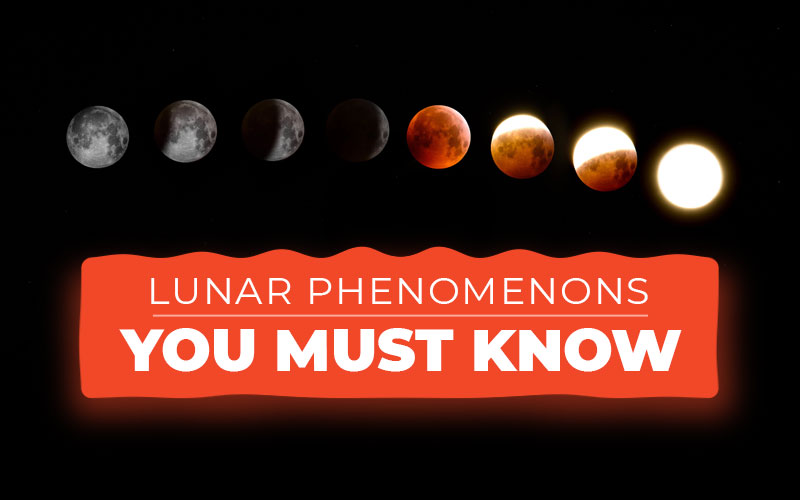
Lunar Phenomenons: You Must Know
The moon is a constant and mysterious presence in our night sky that has a wide range of effects on our planet. Its repetitive pull creates tides and sculpts Earth's oceans. We are constantly reminded of the moon's enduring beauty and the celestial treasures it bestows upon us when we gaze up at the night sky.
Our Lady Luna's lasting influence masterfully arranges spectacular cosmic events. These lunar occurrences spark our curiosity, direct our attention upward, and cultivate a deep appreciation for the cosmic marvels that surround us. People from all walks of life are still amazed and fascinated by its brilliant appearance and the heavenly occurrences it causes. This blog explores the moon's mesmerising effect on our planet and the numerous celestial events that punctuate its endless journey across space.
Lunar Eclipse/Blood Moon:
For years, astronomers and Selenophiles have been fascinated and perplexed by lunar eclipses, which are considered to be among the most captivating and mysterious celestial happenings.
A lunar eclipse occurs when Earth is positioned between the moon and the sun during the full moon phase. During a lunar eclipse, the light of the moon is obscured by the shadow of the earth. When the Earth is perfectly between the Sun and the Moon, it casts a shadow on the moon's surface, causing several occurrences to happen. The moon gradually darkens as it passes into Earth's shadow, giving it a faint glow and sometimes a captivating shade of red, resulting in a visually stunning sight known as a 'blood moon.' This poetic term comes from the way some lunar eclipses cause the moon to turn a rich reddish colour. The blood moon phenomenon is caused by Earth's atmosphere. Light from the sun is scattered by the atmosphere of our planet, making way for primarily red wavelengths to reach the moon. This amazing astronomical occurrence demonstrates the interactions between the elements of our planet and the intricate solar system.
The Supermoon:
The supermoon is another full moon event that offers a unique opportunity for photographers and astronomers to witness the moon in all of its splendour.
The supermoon is an astronomical phenomenon that occurs at the opposite end of the moon's celestial spectrum when it gets closer to Earth throughout its elliptical orbit. During the phenomenon, the moon appears in the night sky larger and brighter than it would during a usual full moon. A supermoon occurrence causes the moon's apparent size to grow by roughly 14% and its luminance to increase by over 30% due to its closeness. Even though they are a common sight in the larger scheme of celestial events, people are nonetheless fascinated by supermoons.
The Blue Moon:
The blue moon has always piqued the interest of skygazers and astronomers as a fascinating celestial phenomenon. A blue moon, despite its name, is not defined by colour; rather, it is the result of two full moons occurring in the same calendar month. These lunar occurrences take place because the moon's orbital cycle, which lasts 29.5 days on average, sometimes coincides with the Gregorian/Julian calendar system.
The phrase "once in a blue moon," which refers to exceptional or infrequent occurrences, is where the name "Blue Moon" originates and highlights how uncommon a blue moon is. Even though its name might not fully capture its beautiful features, a blue moon is remarkable for reasons that go far beyond its apparent rarity.
The Harvest Moon:
Harvest moons are a special kind of starry phenomenon that appears in the night sky in the autumn. Known for being connected to the harvest season, this full moon has unique features that make it stand out from other moon phases.
The harvest moon's punctual ascent in the evening sky is what sets it apart. In contrast to other full moons that gradually light up the night, the harvest moon rises quickly after sunset, casting a brilliant illumination over the surrounding area. In the past, farmers understood the usefulness of this lunar occurrence because it increased their working hours during the vital harvest season. The harvest moon is a reminder of the next season and a sign of the ongoing harmony between our planet and the celestial bodies that remain vigilant around us.
Hunter's Moon:
One full moon that stands out for being October-based is the Hunter's Moon, which occurs immediately after the Harvest Moon, which usually occurs in September. Other names for the Hunter's Moon in various cultures include the Blood Moon or Dying Grass Moon, because of the reddish or orange hue it might occasionally take on when it rises in the evening sky. The longer red wavelengths dominate because shorter wavelengths are scattered by the moon's light as it travels through Earth's atmosphere, causing this effect. The reason it's called the Hunter's Moon is that, in the past, it gave hunters more light to hunt and kill their prey in the autumn.
In many cultures and regions of the world, the Hunter's Moon symbolises the passage of the seasons, from the bountiful harvest season to the time of year when people must rely on hunting for their sustenance, serving as a reminder of life's natural cycles.
In the end, the anticipation of these phenomena by astronomers and skywatchers around the world goes beyond their breathtaking beauty. The moon is more than just a celestial body; these events provide invaluable insights into the dynamics of our cosmic proximities, offering a tangible reminder of the interconnected relationship between Earth, Moon, and Sun and the precision inherent in celestial mechanics. Its visual splendour serves as a perpetual reminder of the moon's central role in the night sky and its enduring significance in human culture and mythology. As well, these events offer a unique opportunity to delve into the intricacies of lunar and calendar mechanics, gently underscoring the precision that underlies astronomical phenomena and the profound connection between the celestial realm and human culture.
Disclaimer: The opinions expressed in this article are those of the author's. They do not purport to reflect the opinions or views of The Critical Script or its editor.

Newsletter!!!
Subscribe to our weekly Newsletter and stay tuned.

















Related Comments